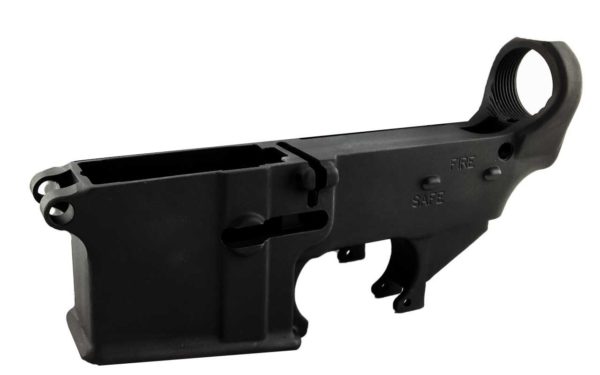Picking Your AR's 80 Percent Lower: Aluminum vs. Polymer
Posted by Gun Builders Depot on Apr 20th 2019
Polymer 80 percent lowers are making waves in the AR market, offering new builders lower costs, easier machining, and comparable performance to traditional alloy 80% lowers. Seasoned builders have given the new polymer lower a passing grade - but are they worth it? In sizing up all the available 80 lowers, should you opt for aluminum or polymer? Let's compare the two and find out what's best.
![]() Polymer vs. aluminum 80 percent lowers: Cost
Polymer vs. aluminum 80 percent lowers: Cost
The idea of building an AR-15 at home with an 80% lower was born by two principles: Convenience and cost. Such lowers allow us to circumvent government red tape and needless fees, while also saving a ton of cash by avoiding the retail gun store markup.
Typical aluminum 80 lowers - both billet and forged - typically start at similar, sub-$100 price points. However, most do not include the requisite 80% jig:
- 80% Lower Fire/Safe Marked Forged (1-Pack)
- Premium 80% Lower Fire/Safe Marked Billet (1-Pack)
- .308 80% Lower Fire/Safe Marked (1-Pack)
Winner: Polymer
Polymer vs. aluminum: Build difficulty
Machining an 80% lower is simple. Whether you're building with polymer or aluminum, you'll be required to drill a few holes. You'll also have to use a handheld router (we recommend the Porter Cable 6430) with an end mill bit (for aluminum) or a Dremel (for polymer) to hollow out the fire control group area inside the receiver.
Obviously, machining plastic is much quicker than machining aluminum, but polymer is also much less forgiving. One small mistake with a hand tool could ruin a polymer lower and its 80% jig. Small mistakes made on an aluminum lower can often be corrected or at least forgiven without compromising the integrity of the finished receiver.
If you damage your 80% jig while machining an aluminum lower, you can easily replace individual components for a few bucks. Polymer 80% jigs are considered "pass" or "fail" - once compromised, they're worthless. You'll also find that machining aluminum is surprisingly easy, and end mill bits provide plenty of control and precision. Considering all factors and risk, we find no clear winner in this battle.
Winner: Tie
Polymer vs. aluminum: Weight
You probably won't be surprised, but polymer 80% lowers clearly win the battle when competing for weight. The Polymer 80 Phoenix G150 V2 80% lower receiver weighs about 1.1 pounds with a lower parts kit installed, making it one of the lightest 80 percent lowers available on the market.
The typical billet 80% lower weighs about 2.15 pounds with a complete lower parts kit installed. This means the typical polymer 80 lower weighs 50% less than an aluminum billet lower. The difference will be even greater when comparing polymer to a forged lower!
Winner: Polymer
Polymer vs. aluminum: Performance
You may have found yourself reading this very article after having scoured forums and posts. Maybe you've read some horror stories about polymer 80 lowers failing or exploding once completed. First, we'd like to dispel any concerns: The polymer lowers we currently sell have been tested, re-designed, and proven in numerous builds already.
Polymer 80 even took time to update the G150 Polymer 80% Lower, making the V2 version even stronger. A solid core design, stiffened mag well, and beefier mil-spec buffer tube housing all ensure this the G150 polymer lower is capable of handling whatever caliber you throw though its mag well.
With that said, we recognize polymer firearms have limitations when it comes to heat and sustained firing. The Nylon-core polymer used in most polymer 80 percent lowers has a melting point of 473 degrees Fahrenheit. Billet 6061 T6 aluminum will melt around 1,200 degrees Fahrenheit.
The standard AR-15 uses gas impingement to cycle the bolt, so there is some risk of heat build-up in a polymer 80 lower. However, reaching such extreme temperatures (473 degrees) would take repeated, rapid fire. A piston-driven bolt carrier group would also greatly reduce heat risk in a polymer lower.
Winner: Aluminum
So, which 80 lower should you pick?
Both polymer and aluminum 80 lowers are worthy choices for any AR-15 build, and either lower will perform admirably for the average builder. Polymer lowers require a bit more patience and care during assembly, though they afford lower cost. Aluminum lowers are bomb-proof, capable of handling any abuse you throw at them.
DISCLAIMER: If you are new to the world of DIY gun building, you likely have a lot of questions and rightfully so. It’s an area that has a lot of questions that, without the correct answers, could have some serious implications. At GunBuilders.com, we are by no means providing this content on our website to serve as legal advice or legal counsel. We encourage each and every builder to perform their own research around their respective State laws as well as educating themselves on the Federal laws. When performing your own research, please be sure that you are getting your information from a reliable source.


